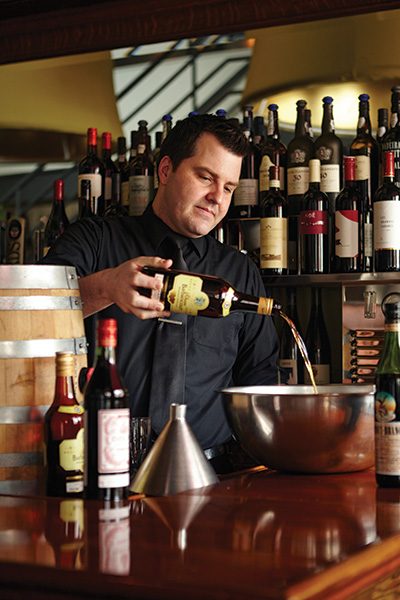
One morning about a year ago, Jim Mullen, general manager and sommelier of the Frog and the Peach in New Brunswick, received a phone call from an old friend, veteran bartender Chris Harrington.
“I have something I want you to try,” Harrington said.
A few hours later, Harrington arrived at the restaurant carrying an empty oak barrel under his arm. Greeting Mullen and chef/owner Bruce Lefebvre, he placed the barrel on the bar and said, “Let’s make a big cocktail.”
A former F&P bartender, Harrington had taken the train from Manhattan, where lately he had been developing barrel-aged cocktails for a Greenwich Village restaurant. The idea of aging cocktails was new to Mullen and Lefebvre. Harrington’s enthusiasm for the results convinced them to give it a try.
In a large plastic container, they mixed roughly a gallon of chamomile Old Fashioned, a Harrington recipe calling for rye, vermouth and simple syrup infused with chamomile and a splash of vodka. They funneled the liquid into the barrel and hammered home the bung. Six weeks later, after tasting once or twice along the way, Mullen and Lefebvre poured themselves their first barrel-aged cocktail.
“I was absolutely amazed and blown away at how it blossomed in the barrel,” says Mullen. What had transpired? “Given that I’m not a chemist,” he says, “the effects of the wood and the air and their melding together create a cocktail that becomes thoroughly integrated, round, seamless, deep, almost lush and, might I say, gentle.”
More specifically, the alcohol extracts tannins, colors and flavors such as vanillin, caramel, spices and toastiness from the wood. The alcohol also oxidizes, creating earthy, nutty flavors. Meanwhile, the acid in the cocktail extracts hemicellulose (essentially, sugar molecules) from the oak, which helps mellow out harshness.
Barrel aging has caught on in cities around the country since Jeffrey Morgenthaler, an influential Portland, Oregon, bartender, wrote about it in his blog (jeffreymorgenthaler.com) in 2010. On a trip to London, Morgenthaler had visited award-winning mixologist Tony Conigliaro and was amazed by the cocktails Conigliaro was aging in glass jars at his bar at 69 Colebrooke Row. Back in Portland, Morgenthaler began aging cocktails on a larger scale, using oak barrels for the flavors they impart. (Barrel aging, by the way, is easily tried at home. Instructions and equipment are available online.)
Not all cocktails can be aged. Carbonated beverages go flat in the barrel; dairy and fruit juices spoil. Lighter liquors, such as gin, vermouth and Aperol, take less time to age, while heavier liquors, like bourbon and scotch, take longer.
All oak barrels are not created equal. Sherry barrels lend extra sweetness to the spirit. In New York, Portland and San Francisco, some mixologists are experimenting with maple-syrup and vinegar barrels. The Frog and the Peach sticks with old bourbon barrels, which are charred on the inside before being filled with whiskey and impart coconut, toast and spice notes.
In New Jersey, the Frog and the Peach (frogandpeach.com) is one of just a few high-end restaurants to take up barrel aging. At Ninety Acres in Peapack-Gladstone, head bartender Christina D’Orta recently presented a couple of barrel-aged cocktails as a special at the bar “to see what the crowd thought, and it was a great turnout.” She has experimented with different kinds of barrels, including one that executive chef David C. Felton used to age the house hot sauce. D’Orta used that barrel to age a spicy margarita. The result, she says, “mellowed the smokiness in the mezcal and hot sauce and brought just the right amount of heat.” The result was “mind-blowing.” The Ryland Inn is aging cocktails as well. At Elements in Princeton, bar manager Jamie Dodge started barrel aging late last year, using new, charred-oak barrels. “Guests definitely appreciate the complexity which the oak brings,” he says.
Ninety Acres charges a dollar or two more for its aged cocktails; Elements does not. At the Frog and the Peach, either kind costs $12. F&P bartenders Jeremy Fisher and Phil Fazio are active participants in the program. Classics that age well, they say, include the Vieux Carré (Rittenhouse rye, Armagnac, sweet vermouth, Benedictine, bitters) and the negroni (gin, Campari, sweet vermouth). New creations work well, too: Lefebvre and pastry chef Joe Ederly created the Blue Seat Mojo (Mount Gay rum, Bacardi Silver rum, Punt e Mes sweet vermouth, orange bitters, coriander seed and cinnamon simple syrup).
Regular cocktails far outsell aged ones at the Frog and the Peach. But a few sips can convert a skeptic. As Mullen recalls, “The first time we unbarreled the chamomile Old-Fashioned, a regular at the bar tasted it and said, ‘This is really dangerous. I could drink about six of these.’”
